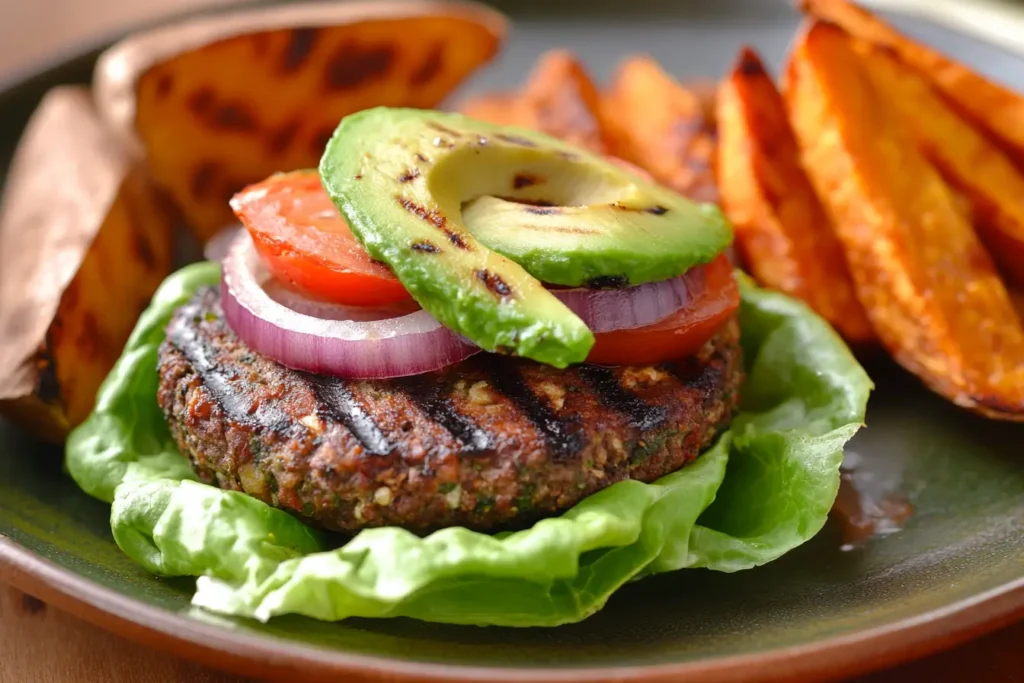Hamburgers are a beloved classic, enjoyed worldwide. But let’s face it—traditional burgers often get a bad rap for being unhealthy. Is it possible to savor this iconic dish without sabotaging your health goals? Absolutely! By making smart ingredient swaps, choosing better cooking methods, and eating mindfully, you can create a burger that’s both delicious and nutritious. This article dives deep into what is the healthiest way to eat a hamburger, offering tips and tricks to enjoy burgers guilt-free while maintaining a balanced diet. Let’s explore!
Table of Contents
Understanding the Basics of a Healthy Hamburger
What Makes a Hamburger Healthy?
A hamburger can be a balanced meal when crafted thoughtfully. The key is to consider the macronutrients—protein, carbs, and fats. Each plays a role in making your burger not just tasty but also nourishing. Protein fuels muscle repair and energy, carbs provide the necessary energy boost, and fats support overall health when consumed in moderation.
But balance is vital. For instance, a patty made with lean meat or plant-based proteins can pack a nutritious punch without excessive saturated fats. Similarly, the bun shouldn’t overshadow the meal with unnecessary carbs and calories—opt for healthier options instead.
Nutritional Pitfalls of Traditional Burgers
While hamburgers can be wholesome, many traditional versions come loaded with nutritional traps. Extra-large portions, fried patties, and sugary sauces are common culprits that increase calorie counts and diminish the health benefits of this versatile dish.
- Calories and fat overload: Typical burgers often include fatty cuts of meat, cheese, and bacon. These ingredients add up quickly, exceeding daily recommended fat and calorie intakes.
- Hidden sodium and sugars: Processed condiments like ketchup, barbecue sauce, and mayonnaise sneak in significant amounts of sodium and sugar, which may contribute to health issues over time.
Understanding these pitfalls is the first step to crafting a burger that’s not only flavorful but also kind to your body.
Choosing Healthier Ingredients for Your Burger
Healthier Protein Options
The foundation of any burger is its patty, and choosing a healthier protein source makes all the difference. For those who prefer meat, lean options like ground turkey, chicken, or bison are excellent substitutes for traditional ground beef. These choices are lower in saturated fats, making them better for heart health.
If you’re embracing a plant-based lifestyle, patties made from black beans, lentils, or tofu provide protein-packed alternatives. They’re also high in fiber, helping to keep you fuller longer while aiding digestion. Plus, plant-based patties tend to have fewer calories and less fat compared to conventional options.
Whole-Grain or Low-Carb Buns
The bun is often an overlooked part of a burger. But swapping out traditional white bread buns for whole-grain or multigrain varieties can elevate your meal’s nutritional profile. Whole grains are richer in fiber, which supports better digestion and stabilizes blood sugar levels.
For those watching their carb intake, alternatives like lettuce wraps or portobello mushroom caps can replace the bun entirely, reducing calories while adding crunch and flavor. Creative swaps like these help make your burger more health-conscious without compromising on satisfaction.
Smart Additions: Toppings and Condiments
What is the healthiest way to eat a hamburger if not by loading it with nutrient-dense toppings? Fresh vegetables like lettuce, tomatoes, onions, and cucumbers not only add vibrant colors but also pack essential vitamins and minerals.
Swap traditional mayo with healthier spreads like Greek yogurt, hummus, or mashed avocado for creaminess minus the guilt. Additionally, opt for low-sodium condiments and avoid those with added sugars, like many ketchup varieties.

For an innovative way to serve your burger ingredients, consider a burger bowl recipe, where the components of a burger are reimagined in a bowl form for a lighter, carb-conscious meal.
Cooking Methods That Retain Nutrition
Grilling vs. Frying: Pros and Cons
When it comes to cooking your burger, how you cook matters just as much as what you eat. Grilling is a classic choice because it allows excess fat to drip away, creating a flavorful yet leaner patty. However, it’s essential to avoid overcooking or charring, as this can produce harmful compounds.
On the other hand, frying in a pan adds extra fat, especially if you use butter or oil liberally. If frying is your preference, consider a non-stick pan or air frying to minimize added fats while retaining that crispy texture.
Alternative Cooking Techniques
If you’re curious about what is the healthiest way to eat a hamburger, exploring alternative cooking methods can be enlightening. Baking burgers in the oven is a hands-free way to cook them evenly, while air frying creates a crisp exterior with minimal oil. Both methods are excellent for maintaining flavor and nutritional integrity.
Avoiding Harmful Compounds in Cooking
High heat can cause the formation of compounds like heterocyclic amines (HCAs), which may be harmful when consumed in large quantities. To minimize these risks, cook your patties at moderate temperatures and use marinades rich in antioxidants, such as those with lemon juice or vinegar.

Learn more about the healthiest ways to prepare and cook your meals to retain maximum nutrition and flavor.
Building a Balanced Burger Meal
Complementing with Healthy Sides
What is the healthiest way to eat a hamburger? It’s not just about the burger itself but also what you pair with it. Skip the greasy fries and go for nutrient-rich sides like roasted sweet potato wedges. They’re packed with vitamins and have a natural sweetness that complements savory burgers. If you prefer lighter options, try a fresh garden salad with leafy greens, cucumbers, and a drizzle of olive oil.
Another great choice is grilled or roasted vegetables, such as zucchini, asparagus, or bell peppers. These sides not only add texture and color but also boost your fiber and antioxidant intake.
Pairing with Nutrient-Rich Beverages
A well-rounded burger meal also includes a thoughtful drink. Sugary sodas can overshadow your healthy burger, so consider alternatives like unsweetened iced tea or infused water with fruits like lemon and mint. These options are refreshing and keep you hydrated without unnecessary sugars.
For a more creative twist, a low-sugar smoothie or a protein shake can provide extra nutrients and make your meal more satisfying.
Mindful Eating Habits
Beyond what’s on your plate, mindful eating plays a big role in health. Eating slowly and savoring each bite helps with digestion and prevents overeating. Plus, it gives you time to truly enjoy your meal without rushing.
Tips for Eating Healthier Burgers at Restaurants

How to Navigate Menu Options
When dining out, finding a healthy burger might seem like a challenge, but it’s not impossible. Many restaurants now offer leaner options like turkey or veggie patties. Look for menu descriptions with keywords like grilled, baked, or roasted, as these indicate healthier preparation methods.
Avoid burgers labeled “double” or “loaded,” as these often come with extra calories from bacon, cheese, or fried additions. Instead, opt for simpler burgers and add your own flair by requesting extra veggies.
Customizing Your Order
Don’t be shy about customizing your burger! Swapping a regular bun for a lettuce wrap or whole-grain bun is a smart move. You can also request sauces on the side to control portions or replace calorie-dense spreads with mustard or avocado.
Many restaurants are happy to accommodate substitutions like extra greens or a side salad instead of fries. Customizing gives you control over your meal and helps align it with your health goals.
Best Chain Restaurants for Healthy Burgers
Fast-food chains have adapted to health-conscious diners, offering better burger options. For example, many now feature impossible burgers or leaner patties made with turkey or chicken. Some even allow you to mix and match toppings to create a burger that suits your diet. A little research before heading out can help you identify these better choices.
For a lighter take on enjoying burgers at home, explore our burger bowl recipe to keep things fresh and health-focused.
Common Myths About Burgers and Health
Myth: Burgers Can’t Be Part of a Healthy Diet
Many people assume that hamburgers are inherently unhealthy, but that’s far from the truth. What is the healthiest way to eat a hamburger? It starts with thoughtful choices. When made with lean protein, whole-grain buns, and fresh toppings, burgers can be a balanced meal. In fact, a well-prepared burger provides a good mix of protein, fiber, and healthy fats. It’s all about moderation and making swaps that fit your nutritional needs.
Fast-food chains and restaurants often serve oversized portions loaded with extra calories. However, if you control portion sizes and focus on wholesome ingredients, burgers can be part of a healthy lifestyle.
Myth: Plant-Based Patties Are Always Healthier
Plant-based patties are popular, but they aren’t automatically healthier than meat options. While they tend to be lower in saturated fat, some are heavily processed and contain additives or excess sodium. For example, many pre-packaged veggie patties lack the natural nutrients found in whole plant foods.
To maximize the benefits of plant-based burgers, choose homemade options or brands with minimal ingredients. Adding nutrient-dense toppings, like avocado or spinach, can make these patties even more nourishing.
Final Tips for Healthy Burger Enjoyment
Practical Tips for Meal Prepping Burgers
Meal prepping is a great way to control the quality of your food while saving time. To prepare healthy burgers, cook patties in bulk using lean meats or legumes. Store them in airtight containers, separating layers with parchment paper for easy reheating.
For added convenience, pre-chop your toppings and portion out healthier condiments. This ensures that assembling a nutritious burger takes just minutes, making it easier to stay on track with your health goals.
Staying Mindful During Burger Meals
When it comes to savoring your burger, slow down and focus on each bite. Eating mindfully helps you enjoy your meal fully while reducing the chance of overeating. Pair your burger with colorful sides and a refreshing drink to create a balanced plate.
Remember, what is the healthiest way to eat a hamburger isn’t a one-size-fits-all answer—it depends on your preferences and health goals. The key is to make informed choices and enjoy every bite.
Conclusion
Burgers are one of the most iconic and universally loved meals, but their reputation as a “junk food” can make many people hesitant to indulge. However, when approached thoughtfully, hamburgers can be as nutritious as they are delicious. The key lies in redefining your burger-building strategy and making choices that align with your health goals. This article explored what is the healthiest way to eat a hamburger, offering practical tips to transform this comfort food into a balanced and satisfying meal.
Reinventing the Classic Burger
At the heart of creating a healthy burger is rethinking its basic components. Start with the patty—lean meats like turkey, chicken, or even bison offer a protein-packed foundation without the excess saturated fat found in traditional ground beef. Plant-based patties made from black beans, lentils, or tofu add variety and nutrients, catering to vegetarians and anyone seeking to reduce meat consumption.
The bun, often an overlooked part of the burger, can make or break its nutritional profile. Opt for whole-grain buns to add fiber and essential nutrients or go bun-less with lettuce wraps for a lighter, low-carb option. Each of these changes can significantly cut calories while increasing the overall health benefits of your meal.
Balancing Your Burger Plate
Burgers don’t exist in isolation; the sides and condiments you choose also play a significant role in determining whether your meal supports or sabotages your health. Traditional fries and sugary sodas can quickly add unnecessary calories, fats, and sugars. Instead, consider pairing your burger with roasted vegetables, a vibrant side salad, or even a small portion of baked sweet potato fries. As for beverages, swapping out sugary sodas for infused water, unsweetened iced tea, or sparkling water helps keep the focus on nutrition.
Additionally, the toppings on your burger should contribute to its nutritional value rather than detract from it. Fresh vegetables like lettuce, tomatoes, onions, and cucumbers not only enhance flavor but also add important vitamins, minerals, and antioxidants. When it comes to spreads and condiments, swapping mayonnaise for avocado or Greek yogurt keeps the creaminess while cutting back on unhealthy fats. Even your choice of cheese can make a difference—selecting lower-fat or reduced-sodium varieties helps maintain balance.
The Role of Mindfulness
Eating mindfully is another critical aspect of enjoying hamburgers in a healthy way. Mindfulness is about being present during your meals, savoring each bite, and recognizing when you’re full. When you slow down and pay attention to your meal, you’re less likely to overeat and more likely to appreciate the flavors and textures of your food.
Another important consideration is portion control. While burgers served in restaurants often lean toward being oversized, you have the power to downsize your portions at home. A smaller patty paired with nutrient-rich sides can create a well-rounded, satisfying plate without overwhelming your calorie count for the day.
Flexibility and Variety
One of the most exciting aspects of burgers is their versatility. With countless combinations of proteins, buns, toppings, and sides, there’s no shortage of ways to customize your meal. This flexibility allows you to adapt your burger to fit dietary preferences, whether you’re following a low-carb, vegetarian, or high-protein diet.
If you’re dining out, don’t hesitate to customize your order. Many restaurants now offer healthier options like grilled patties, lettuce wraps, and extra vegetables. Asking for sauces on the side or swapping fries for a side salad are small yet impactful ways to make your burger meal better for you.
A Guilt-Free Approach to Burgers
Ultimately, what is the healthiest way to eat a hamburger comes down to balance and choice. Burgers don’t have to be indulgent “cheat meals”; with the right ingredients and preparation methods, they can become part of a healthy, sustainable diet. It’s not about eliminating burgers from your life—it’s about enjoying them in a way that aligns with your health goals.
Whether you’re grilling patties at home, trying a veggie-based recipe, or customizing an order at your favorite restaurant, you now have the tools to make informed choices. So, go ahead and enjoy the classic flavors of a burger while fueling your body with the nutrients it needs. By taking control of your ingredients, portions, and sides, you can relish every bite guilt-free.
Burgers are more than just a meal; they’re a celebration of flavor, versatility, and creativity. With a little effort, you can enjoy this beloved dish in a way that’s both delicious and nourishing. Now, fire up that grill, pile on the veggies, and redefine the way you eat burgers for good!
Dernière mise à jour : 10 February 2025

